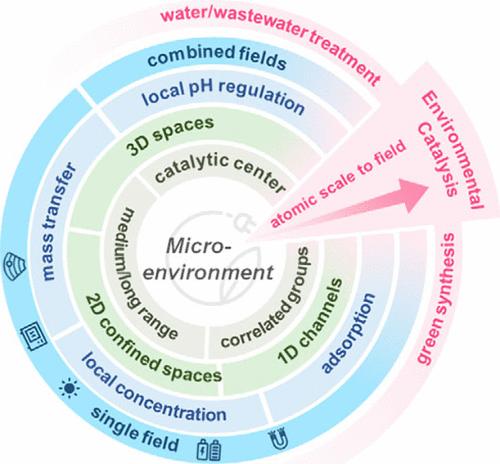当前位置:
X-MOL 学术
›
Chem. Rev.
›
论文详情
Our official English website, www.x-mol.net, welcomes your
feedback! (Note: you will need to create a separate account there.)
Microenvironment Engineering of Heterogeneous Catalysts for Liquid-Phase Environmental Catalysis
Chemical Reviews ( IF 51.4 ) Pub Date : 2024-10-09 , DOI: 10.1021/acs.chemrev.4c00276 Zhong-Shuai Zhu, Shuang Zhong, Cheng Cheng, Hongyu Zhou, Hongqi Sun, Xiaoguang Duan, Shaobin Wang
Chemical Reviews ( IF 51.4 ) Pub Date : 2024-10-09 , DOI: 10.1021/acs.chemrev.4c00276 Zhong-Shuai Zhu, Shuang Zhong, Cheng Cheng, Hongyu Zhou, Hongqi Sun, Xiaoguang Duan, Shaobin Wang

|
Environmental catalysis has emerged as a scientific frontier in mitigating water pollution and advancing circular chemistry and reaction microenvironment significantly influences the catalytic performance and efficiency. This review delves into microenvironment engineering within liquid-phase environmental catalysis, categorizing microenvironments into four scales: atom/molecule-level modulation, nano/microscale-confined structures, interface and surface regulation, and external field effects. Each category is analyzed for its unique characteristics and merits, emphasizing its potential to significantly enhance catalytic efficiency and selectivity. Following this overview, we introduced recent advancements in advanced material and system design to promote liquid-phase environmental catalysis (e.g., water purification, transformation to value-added products, and green synthesis), leveraging state-of-the-art microenvironment engineering technologies. These discussions showcase microenvironment engineering was applied in different reactions to fine-tune catalytic regimes and improve the efficiency from both thermodynamics and kinetics perspectives. Lastly, we discussed the challenges and future directions in microenvironment engineering. This review underscores the potential of microenvironment engineering in intelligent materials and system design to drive the development of more effective and sustainable catalytic solutions to environmental decontamination.
中文翻译:

用于液相环境催化的非均相催化剂的微环境工程
环境催化已成为减轻水污染和推进循环化学的科学前沿,反应微环境显着影响催化性能和效率。本文深入探讨了液相环境催化中的微环境工程,将微环境分为四个尺度:原子/分子级调制、纳米/微米级限域结构、界面和表面调节以及外部场效应。分析了每个类别的独特特性和优点,强调其显著提高催化效率和选择性的潜力。在此概述之后,我们介绍了先进材料和系统设计的最新进展,以利用最先进的微环境工程技术促进液相环境催化(例如,水净化、向增值产品的转化和绿色合成)。这些讨论展示了微环境工程被应用于不同的反应中,以微调催化机制并从热力学和动力学的角度提高效率。最后,我们讨论了微环境工程的挑战和未来方向。本综述强调了微环境工程在智能材料和系统设计方面的潜力,以推动开发更有效和可持续的环境净化催化解决方案。
更新日期:2024-10-09
中文翻译:

用于液相环境催化的非均相催化剂的微环境工程
环境催化已成为减轻水污染和推进循环化学的科学前沿,反应微环境显着影响催化性能和效率。本文深入探讨了液相环境催化中的微环境工程,将微环境分为四个尺度:原子/分子级调制、纳米/微米级限域结构、界面和表面调节以及外部场效应。分析了每个类别的独特特性和优点,强调其显著提高催化效率和选择性的潜力。在此概述之后,我们介绍了先进材料和系统设计的最新进展,以利用最先进的微环境工程技术促进液相环境催化(例如,水净化、向增值产品的转化和绿色合成)。这些讨论展示了微环境工程被应用于不同的反应中,以微调催化机制并从热力学和动力学的角度提高效率。最后,我们讨论了微环境工程的挑战和未来方向。本综述强调了微环境工程在智能材料和系统设计方面的潜力,以推动开发更有效和可持续的环境净化催化解决方案。


















































 京公网安备 11010802027423号
京公网安备 11010802027423号